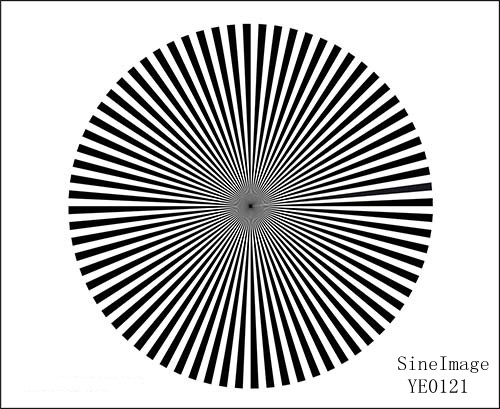
The sine version has smoother black to white transitions than the square wave version on the left. The pattern you see here on the page is a consequence of downsampling the image to 600 pixels wide.

#SIEMENS STAR CHAR FULL SIZE#
In the printed chart and in the full size file the star lines go all the way to the white center disk. I found that in testing I rarely used the low contrast resolution pattern on the right side of the chart so I replaced it with a sine Siemens star pattern with small text in the center. UPDATE:I've updated the chart to make it more useful. A black border is used to look for chromatic aberration as will also be described later. There are also a small texture patches and text blocks on the left and right at the foot of the chart which can be used for visual assessment of image quality.

Below the test patterns is a line which is exactly 100mm long that can be used for calibration as described later. Within the resolution patterns on each side is a Siemens star pattern.

In the center is a checkerboard pattern which is used for focusing. There's a high contrast set on the left of center and a low contrast set on the right of center. The lens testing resolution patterns are based on those used for the NBS 1010A test chart. If the target is used at the intended distance, you won't be using anything past the 2.8 or maybe 3.2 line sets anyway. The lines in the test patterns should be well resolved down to at least the 5.0 lp/mm line set. With the lens testing target printed on glossy paper, most printers should be capable of printing a good quality target when set to their maximum quality settings.
#SIEMENS STAR CHAR DOWNLOAD#
You can download a high resolution printable version of this image (as a Zipped JPEG) via THIS LINK. If you were doing lens testing using a full frame DSLR, you'd put the targets at the center and corners of a 24" x 36" rectangle to get the same magnification ratio. For APS-C sensor cameras I usually place them on a 15"x22" background and if that fills the frame, the magnification of the system will be around 1:25 which for a number of reasons is a good number to show the typical performance of a lens. Now a 4圆 target isn't very big, so the idea is to print a number of them and place them in the center and at the corners of a larger chart. The lens testing chart I'm going to use can be printed on 4圆 card. If you want something to do lens testing that's a little quicker and easier (and much cheaper) then you can do some simpler tests using a test chart as described below. It can give you a lot of technical information on an lens (if you do the tests right) and it's an excellent package, but even the "lite" version is pretty complex and more than most people want to deal with. I won't go into details of it here since you can find everything you'd ever need to know on their website.
#SIEMENS STAR CHAR PRO#
It's currently (2013) $299 for the "lite" version and $2200 for the pro version (though a limited free trial edition is available). If you want to go all the way, I'd recommend you look at the Assuming you have a camera and lens in good calibration and you are getting an accurate indication of focus by the AF system, then what?Īt this point you have to decide just how much effort you want to put into measuring the optical characteristics of your lens. To do that you have to do some focus testing as I described in the article HERE. Well, you have to be sure that the lens is focusing properly. So you have the camera on a tripod, what's next. If the shutter speed is high enough and your hands are steady enough, you may get a critically sharp image, but don't bet on it happening every time. Photographers don't realize that hand holding a camera (even if it or the lens has image stabilization), isn't the way to get the maximum possible sharpness.

Well, unless you're shooting a static subject with the camera and lens on a tripod, it probably doesn't mean much. Probably the most frequent complaint or cause for concern about a lens is that it's not sharp, but what does that mean? Part 6 - Lens Testing for Resolution, Chromatic Aberration and Distortion


 0 kommentar(er)
0 kommentar(er)
